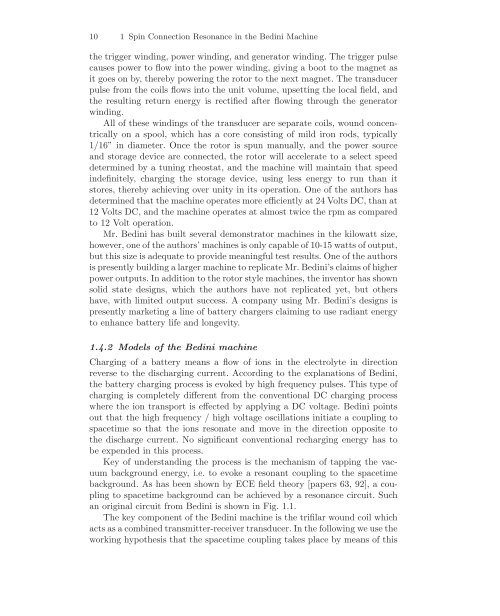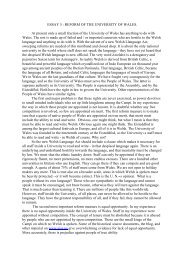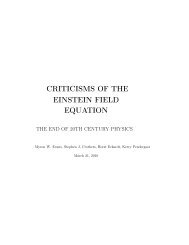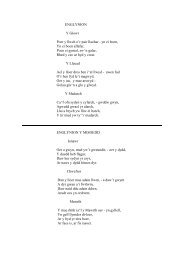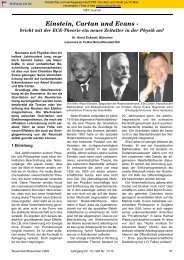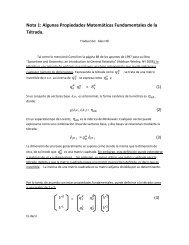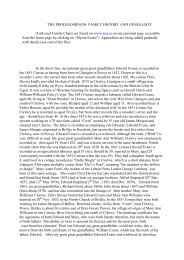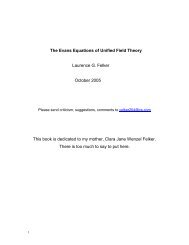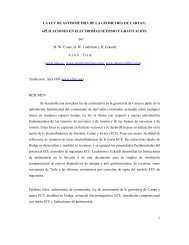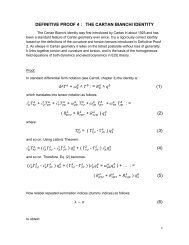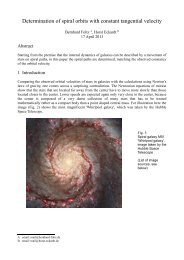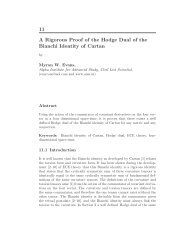Spin Connection Resonance in the Bedini Machine - Alpha Institute ...
Spin Connection Resonance in the Bedini Machine - Alpha Institute ...
Spin Connection Resonance in the Bedini Machine - Alpha Institute ...
Create successful ePaper yourself
Turn your PDF publications into a flip-book with our unique Google optimized e-Paper software.
10 1 <strong>Sp<strong>in</strong></strong> <strong>Connection</strong> <strong>Resonance</strong> <strong>in</strong> <strong>the</strong> Bed<strong>in</strong>i Mach<strong>in</strong>e<br />
<strong>the</strong> trigger w<strong>in</strong>d<strong>in</strong>g, power w<strong>in</strong>d<strong>in</strong>g, and generator w<strong>in</strong>d<strong>in</strong>g. The trigger pulse<br />
causes power to flow <strong>in</strong>to <strong>the</strong> power w<strong>in</strong>d<strong>in</strong>g, giv<strong>in</strong>g a boot to <strong>the</strong> magnet as<br />
it goes on by, <strong>the</strong>reby power<strong>in</strong>g <strong>the</strong> rotor to <strong>the</strong> next magnet. The transducer<br />
pulse from <strong>the</strong> coils flows <strong>in</strong>to <strong>the</strong> unit volume, upsett<strong>in</strong>g <strong>the</strong> local field, and<br />
<strong>the</strong> result<strong>in</strong>g return energy is rectified after flow<strong>in</strong>g through <strong>the</strong> generator<br />
w<strong>in</strong>d<strong>in</strong>g.<br />
All of <strong>the</strong>se w<strong>in</strong>d<strong>in</strong>gs of <strong>the</strong> transducer are separate coils, wound concentrically<br />
on a spool, which has a core consist<strong>in</strong>g of mild iron rods, typically<br />
1/16” <strong>in</strong> diameter. Once <strong>the</strong> rotor is spun manually, and <strong>the</strong> power source<br />
and storage device are connected, <strong>the</strong> rotor will accelerate to a select speed<br />
determ<strong>in</strong>ed by a tun<strong>in</strong>g rheostat, and <strong>the</strong> mach<strong>in</strong>e will ma<strong>in</strong>ta<strong>in</strong> that speed<br />
<strong>in</strong>def<strong>in</strong>itely, charg<strong>in</strong>g <strong>the</strong> storage device, us<strong>in</strong>g less energy to run than it<br />
stores, <strong>the</strong>reby achiev<strong>in</strong>g over unity <strong>in</strong> its operation. One of <strong>the</strong> authors has<br />
determ<strong>in</strong>ed that <strong>the</strong> mach<strong>in</strong>e operates more efficiently at 24 Volts DC, than at<br />
12 Volts DC, and <strong>the</strong> mach<strong>in</strong>e operates at almost twice <strong>the</strong> rpm as compared<br />
to 12 Volt operation.<br />
Mr. Bed<strong>in</strong>i has built several demonstrator mach<strong>in</strong>es <strong>in</strong> <strong>the</strong> kilowatt size,<br />
however, one of <strong>the</strong> authors’ mach<strong>in</strong>es is only capable of 10-15 watts of output,<br />
but this size is adequate to provide mean<strong>in</strong>gful test results. One of <strong>the</strong> authors<br />
is presently build<strong>in</strong>g a larger mach<strong>in</strong>e to replicate Mr. Bed<strong>in</strong>i’s claims of higher<br />
power outputs. In addition to <strong>the</strong> rotor style mach<strong>in</strong>es, <strong>the</strong> <strong>in</strong>ventor has shown<br />
solid state designs, which <strong>the</strong> authors have not replicated yet, but o<strong>the</strong>rs<br />
have, with limited output success. A company us<strong>in</strong>g Mr. Bed<strong>in</strong>i’s designs is<br />
presently market<strong>in</strong>g a l<strong>in</strong>e of battery chargers claim<strong>in</strong>g to use radiant energy<br />
to enhance battery life and longevity.<br />
1.4.2 Models of <strong>the</strong> Bed<strong>in</strong>i mach<strong>in</strong>e<br />
Charg<strong>in</strong>g of a battery means a flow of ions <strong>in</strong> <strong>the</strong> electrolyte <strong>in</strong> direction<br />
reverse to <strong>the</strong> discharg<strong>in</strong>g current. Accord<strong>in</strong>g to <strong>the</strong> explanations of Bed<strong>in</strong>i,<br />
<strong>the</strong> battery charg<strong>in</strong>g process is evoked by high frequency pulses. This type of<br />
charg<strong>in</strong>g is completely different from <strong>the</strong> conventional DC charg<strong>in</strong>g process<br />
where <strong>the</strong> ion transport is effected by apply<strong>in</strong>g a DC voltage. Bed<strong>in</strong>i po<strong>in</strong>ts<br />
out that <strong>the</strong> high frequency / high voltage oscillations <strong>in</strong>itiate a coupl<strong>in</strong>g to<br />
spacetime so that <strong>the</strong> ions resonate and move <strong>in</strong> <strong>the</strong> direction opposite to<br />
<strong>the</strong> discharge current. No significant conventional recharg<strong>in</strong>g energy has to<br />
be expended <strong>in</strong> this process.<br />
Key of understand<strong>in</strong>g <strong>the</strong> process is <strong>the</strong> mechanism of tapp<strong>in</strong>g <strong>the</strong> vacuum<br />
background energy, i.e. to evoke a resonant coupl<strong>in</strong>g to <strong>the</strong> spacetime<br />
background. As has been shown by ECE field <strong>the</strong>ory [papers 63, 92], a coupl<strong>in</strong>g<br />
to spacetime background can be achieved by a resonance circuit. Such<br />
an orig<strong>in</strong>al circuit from Bed<strong>in</strong>i is shown <strong>in</strong> Fig. 1.1.<br />
The key component of <strong>the</strong> Bed<strong>in</strong>i mach<strong>in</strong>e is <strong>the</strong> trifilar wound coil which<br />
acts as a comb<strong>in</strong>ed transmitter-receiver transducer. In <strong>the</strong> follow<strong>in</strong>g we use <strong>the</strong><br />
work<strong>in</strong>g hypo<strong>the</strong>sis that <strong>the</strong> spacetime coupl<strong>in</strong>g takes place by means of this


